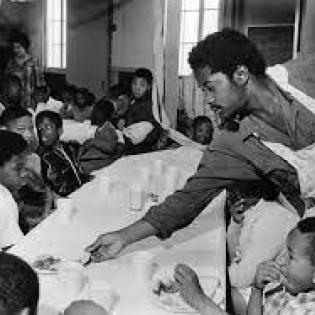Mutual Aid and School Breakfast
The Free Breakfast for Children Program of the 1960s exemplified mutual aid and differed from traditional charity while still being a form of philanthropy. We discover and learn how the people of a community most affected by issues, including young people, are sometimes the most able to find ways forward to address needs.
The learner will know and be able to:
- define mutual aid and give examples.
- connect past civil rights actions to current efforts.
- copy of The Free Breakfast for Children Program overview (see handouts below)
- Youth can explore the History of U.S. Philanthropy timeline to read stories of people taking action for justice.
How can mutual aid initiatives shape a more equitable society today and in the future?
What can young people do to get involved in solving issues that affect them and their community?
Instructions
Opening Discussion:
What is the current status of free breakfast programs, and how does free breakfast for children impact learning and community well-being?
Background:
During the 1960s and 1970s, the Black Panther Party started a free breakfast program to provide meals to children in underserved communities. This program was not just about charity, which can create an imbalanced giver-to-receiver relationship, but it exemplified the principles of mutual aid, which is based on mutual benefit and is facilitated by the people most affected by the need.Watch this video about mutual aid. Define and compare mutual aid, charity, and philanthropy. Discuss what the phrase, "Do nothing for us without us" means to you.
Read the paper below with an overview of the Free Breakfast for Children program of the 1960s. Answer these questions as you read:
- In what ways is the Free Breakfast for Children Program an example of mutual aid?
- What are the differences between mutual aid and traditional charity? What would charity look like in this context?
- What are the elements of philanthropy in the breakfast program?
- How did the program influence government policy? Why?
Discuss the long-term effects of mutual aid initiatives and how they can empower individuals and communities. Why do you think charity does not have the same long-term effects and empowerment?
Create a Venn diagram that includes mutual aid, charity, and philanthropy. Where does the Free Breakfast program fit in the diagram? Add to the Venn diagram 5-10 initiatives in your community that address current needs. Think of nonprofit, advocacy, and volunteer efforts.
Extensions:
- Research and identify current mutual aid initiatives or community-based projects. Learn what they do and how they practice the principle of "do nothing for us without us."
- Sometimes philanthropy experiments with solutions before the government adopts them for all. What issues do you think are more equitably addressed by the government? It could be healthcare, early-childhood education, or environmental issues.
